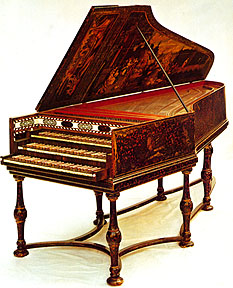Viewed from above or from the position of the player, Italian harpsichords are long and thin. This tends to mean that they have an excellent bass range since the bass strings are long in comparison with others on the instrument. Italian harpsichords also have a little tell-tale “dog-leg” at the bass end of the bridge over which the strings pass. Many Italian harpsichords have only two 8′ ranks of strings rather than two 8′ and a 4′ typical of other national styles. Italian harpsichords also have a somewhat dry sound which makes them ideal for playing continuo.
Italian harpsichord. Toccata in G minor (BWV 915) by J.S. Bach (excerpt), performed by Colin Tilney. Dorian DOR-90115 (1989). Trk 4.
German harpsichords are larger in construction, sound, and tonal resources than any other national type. They sometimes have three keyboards and an almost organ-like profusion of ranks of strings, occasionally including 16′ and 2′ ranks in addition to the 8′ and 4′, giving four octave possibilities for each key. German harpsichords can also be visually identified by the “double bent side,” where the angled end of the French, Flemish, and Italian style instruments is replaced by an additional curve. Perhaps because of the huge case, German harpsichords seem to ring for a long time after the keys are played.
German harpsichord (after Zell). Gelobet seist du, Jesu (excerpt) by Georg Böhm, performed by Edward Parmentier. German Harpsichord Music. Wildboar WLBR 9202 (1998). Trk 21.






